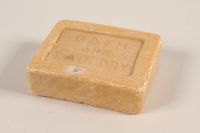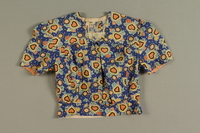Overview
- Brief Narrative
- Drawing done by 20-year old Judith Kessler when she was interned in Bergen-Belsen concentration camp from June-December 1944. Judith and her mother were taken to Bergen-Belsen by train from Budapest, Hungary, as part of a rescue effort organized by Rezso Kasztner. Later in 1944, they were transferred to safety in Switzerland.
- Artwork Title
- Who Can Understand?
- Date
-
creation:
1944 June-1944 December
- Geography
-
received:
Bergen-Belsen (Concentration camp);
Belsen (Bergen, Celle, Germany)
- Credit Line
- United States Holocaust Memorial Museum Collection, Gift of Judith Stieglitz Kessler
- Markings
- back, bottom left corner, printed upsude down by hand in black ink : C 40
- Contributor
-
Subject:
Ms. Yehudit Stieglitz Kessler
- Biography
-
Yehudit Steiglitz was born in Subotica, Yugoslavia (Serbia), on August 28, 1923. She is the only child of Alex Steiglitz, born in 1893 in Sezsmarok, Slovakia, and Ella Hollander, born in 1897 in Szepesvaralja (?) (Spišské Podhradi), Slovakia). Her parents were secular Jews with Zionist leanings. Prior to the war, Alex owned a modern windmill. In April 1941, the Germans invaded Yugoslavia and partitioned it; Hungary was given the northern region that included Subotica. The Hungarians allowed the Jewish students to finish their school exams, thus Yehudit was able to graduate that April. She began to learn how to sew from the seamstress who made clothes for her mother and herself. In April 1944, her father and her uncle were rounded up with other Jewish men and sent to the Topoya holding center. From there, they were deported to Auschwitz concentration camp.
In 1944, Yehudit, her mother, and her grandmother were sent to the ghetto where Yehudit was able to work as a seamstress. After about three weeks, they were sent to the ghetto in Bacsalmas, Hungary. While they were in the ghetto, Hungarians were given possession of their home. A judge was given two of the rooms; he said that he did not need any of their possessions and would protect them. Another family, a Christian woman and her Jewish husband, stayed in the other three rooms; they also said that they would take care of the apartment and the contents.
While they were in the Bacsalmas ghetto, the German commandant received a letter from Budapest listing the names of the Zionists in the area, including Yehudit’s father. Yehudit, her mother, and her grandmother were removed from the ghetto and taken to the synagogue, where they were held all night with the others on the list. In the morning, when they were released, they saw that the ghetto had been evacuated. The inhabitants had been loaded on cattle cars and transported in compliance with the German desire that all Jews be expelled from Hungary. Hungarian police units deported many Jews into the custody of German police, who transported them to Auschwitz-Birkenau, where the majority was killed in the gas chambers. Yehudit and the others, who as Zionists were presumed to have agreed to leave the country for Palestine, were sent to Budapest, and then taken to a synagogue in Pest. There they learned that they were going to be sent by train to Palestine, as part of the Kasztner transport. This was a transfer for money negotiated between the German SS and Rezső Kasztner of the Relief and Rescue Committee of Budapest. Yehudit's grandmother, already quite ill, was taken to a hospital, where she died the next day. However, Kastzner was not able to raise sufficient funds, so the group could not be sent to Palestine. Instead, they were sent to Bergen-Belsen where they were housed separately from the other inmates. They were not allowed to work and were treated fairly well. While there, Yehudit compiled a notebook of the favorite recipes of the other Hungarian inmates. Yehudit and her mother were in Bergen-Belsen from June to December, and then were transferred for safety to Caux, Switzerland. They remained there until after the war ended, and Yehudit worked as a seamstress. They learned that Alex, Yehudit’s father, had died on May 8, 1945, following a death march from Auschwitz, where he had labored in the salt mines, to Bergen-Belsen. Around June 1945, Yehudit and her mother returned to Subotica. They found that their home and belongings had been cared for by the Hungarians who had been given possession of them during the war. Yehudit eventually emigrated to Israel where she married a man named Kessler.
Physical Details
- Classification
-
Art
- Category
-
Drawings
- Object Type
-
Pencil drawing (lcsh)
- Physical Description
- Rectangular, offwhite paper with torn edges with a pencil drawing of the interior of a wooden barrack room with a mop, broom, and some personal items. On the back is a handwritten inscription by the artist.
- Dimensions
- overall: Height: 3.500 inches (8.89 cm) | Width: 5.250 inches (13.335 cm)
- Materials
- overall : paper, graphite
- Inscription
- front, upper left corner, pencil : Baraka & mop krev Fa | III sprat [Barracks and wood mop(?) / III floor]
back, written in pencil : Ko iz svop crteža vidi / šta pretstavlja veƈi je umet / nik nepo njepov toorac. [Who can understand what is in drawing he is a greater artist than me!]
Rights & Restrictions
- Conditions on Access
- No restrictions on access
- Conditions on Use
- No restrictions on use
Keywords & Subjects
Administrative Notes
- Legal Status
- Permanent Collection
- Provenance
- The drawing was donated to the United States Holocaust Memorial Museum in 2008 by Judith Stieglitz Kessler.
- Record last modified:
- 2023-07-10 10:56:00
- This page:
- https://collections.ushmm.org/search/catalog/irn36287
Download & Licensing
In-Person Research
- By Appointment
- Request 21 Days in Advance of Visit
- Plan a Research Visit
- Request to See This Object
Contact Us
Also in Judith Stieglitz Kessler collection
The collection consists of artifacts, documents, and photographs relating to the experiences of Judith (Yehudit) Stieglitz Kessler and her family before, during, and after the Holocaust in Hungary and Yugoslavia.
Date: 1940-1945

Soap from Bergen-Belsen concentration camp
Object
Soap issued to 20-year old Judith Kessler possibly when she was interned in Bergen-Belsen concentration camp from June-December 1944. Judith and her mother were taken to Bergen-Belsen by train from Budapest, Hungary, as part of a rescue effort organized by Rezso Kasztner. Later in 1944, they were transferred to safety in Switzerland.

Blue two-piece dress with multicolored hearts
Object
Dress owned by 20-year-old Judith Kessler and made for her by a seamstress in her hometown of Subotica, Yugoslavia (Serbia.) It was originally a dress, but was modfied into a top and skirt during the war. Judith and her mother were interned in the Bacsalmas ghetto and then deported to Pest, Hungary, by the Hungarian police, following the occupation of the country by the Germans. They were told they were being sent to Palestine, but instead were taken to Bergen-Belsen by train from Budapest as part of a rescue effort organized by Rezso Kasztner. Later in 1944, they were transferred to safety in Switzerland.
Yehudit Stieglitz Kessler collection
Document
Collection of photographs of Yehudit Stieglitz [donor, now Yehudit Kessler] and family members during the Holocaust era. Included is a photo of Jewish students who were omitted from public school celebration holding their own event; photos of the donor and her mother in Caux, Switzerland after arriving on the "Kasztner Train," after spending six months in Bergen Belsen; a notebook of recipes written in Bergen Belsen by the donor with recipes received from other women who lived in her barracks, dated 1944; and a food coupon issued in Caux, Switzerland, dated 1945.



